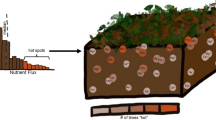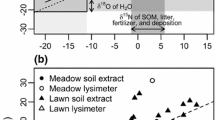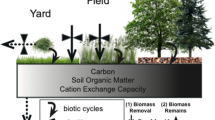Abstract
Re-examination of data distributions from several forested sites in the eastern Sierra Nevada Mountains shows consistent, positive outliers and skew for NH4 +, NO3 −, and mineral N in resin lysimeters and resin capsules, indicating that most values were low but hotspots of high N flux were present in most cases. Exact causes of these N flux hotspots is not known, but could include water flux hotspots (e.g., preferential flowpaths), microbial hotspots, and possibly the entry of N-enriched O horizon interflow. Soil and resin stake (PRS probe) data from one site (North Lake Tahoe) also showed consistent, positive outliers and skew for NH4 +, NO3 −, and mineral N, suggesting the presence of microbially produced hotspots. Bicarbonate-P data from soils and ortho-P data from PRS probes also showed highly positive skew and extreme outliers, but Bray (HCl/NH4F-extractable) P in soils did not. Other measured nutrients (extractable Mg2+, K+, SO4 2−, and Ca2+) also showed positive skew and outliers, but less so than NH4 +, NO3 −, and mineral N. Calcium stood out among measured nutrients as the most abundant nutrient with the least outliers and the lowest (sometimes negative) skew. The differences in distributions of NH4 +, NO3 −, and mineral N and those of Ca2+ may reflect relative abundance: the most abundant ion, Ca2+, shows little evidence of hotspots whereas the much less abundant ions, NH4 +, NO3 − consistently show evidence of hotspots. We hypothesize that the differing distributions of N and Ca reflect the relative biological competition for these nutrients and that positively-skewed distributions and hotspots will be characteristic of any other nutrient when it is in limited supply relative to biological demand.





Similar content being viewed by others
References
Brown JD (1997) Skewness and kurtosis. JALT testing and evaluation SIG newsletter, vol 1, pp 20–23. (http://jalt.org/test/bro_1.htm)
Burcar S, Miller WW, Tyler SW, Johnson DW (1994) Seasonal preferential flow in two Sierra Nevada soils under forested and meadow cover. Soil Sci Soc Am J 58:1555–1561
Cole DW, Rapp M (1981) Elemental cycling in forest ecosystems. In: Reichle DE (ed) Dynamic properties of forest ecosystems. Cambridge University Press, London, pp 341–409
Gardiner DT, Miller RW (2008) Soils in our environment, Eleventh edn. Prentice Hall, Upper Saddle River, New Jersey, USA, pp 147–149
Glass DW (2006) Factors affecting short term nitrogen availability from vegetation fire in the Sierra Nevada. MS Thesis, Graduate Program in Hydrologic Science, University of Nevada, Reno, Nevada USA
Johnson DW (2006) Progressive nitrogen limitation in forests: a review of the literature and implications for long-term responses to elevated CO2. Ecology 87:64–75
Johnson DW, Lindberg SE (eds) (1991) Atmospheric deposition and forest nutrient cycling: a synthesis of the integrated forest study., Ecological Series 91Springer-Verlag, New York, p 707
Johnson DW, Murphy JD, Susfalk RB, Caldwell TG, Miller WW, Walker RF, Powers RF (2005) The effects of wildfire, salvage logging, and post-fire N fixation on the nutrient budgets of a Sierran forest. For Ecol Manag 220:155–165
Johnson DW, Murphy JD, Walker RF, Miller WW, Todd DE (2008) The combined effects of thinning and prescribed fire on carbon and nutrient budgets in a Jeffrey Pine forest. Ann For Sci 65:601–612
Johnson DW, Miller WW, Susfalk RB, Murphy JD, Dahlgren RA, Glass DW (2009) Biogeochemical cycling in forest soils of the eastern Sierra Nevada Mountains, USA. For Ecol Manag 258:2249–2260
Kuo S (1996) Phosphorus. In: Methods of soil analysis, part 3—chemical methods. Soil Science Society of America, Madison, WI, USA, pp 894–895
Likens GE, Bormann FH, Pierce RS, Eaton JS, Johnson NM (1977) Biogeochemistry of a forested ecosystem. Springer-Verlag, New York
Loupe TM, Miller WW, Johnson DW, Sedinger JM, Carroll EM, Walker RF, Murphy JD, Stein CM (2009) Effects of mechanical harvest + chipping and prescribed fire on Sierran runoff water quality. J Environ Qual 38:537–547
McClain ME, Boyer EW, Dent CL, Gergel SE, Grimm NB, Groffman PS, Hart SC, Harvey JW, Johnston CA, Mayorga E, McDowell WH, Pinay G (2003) Biogeochemical hot spots and hot moments at the interface of terrestrial and aquatic ecosystems. Ecosystems 6:301–312
Miller WW, Johnson DW, Denton C, Verburg PSJ, Dana GL, Walker RF (2005) Inconspicuous nutrient laden surface runoff from mature forest sierran watersheds. Water, Air, Soil Pollut 163:3–17
Miller WW, Johnson DW, Loupe TM, Sedinger JS, Carroll EM, Murphy JD, Walker RF, Glass DW (2006) Nutrients flow from runoff at burned forest site in Lake Tahoe Basin. Calif Agric 60:65–71
Murphy JD, Johnson DW, Miller WW, Walker RF, Blank RR (2006a) Prescribed fire effects on forest floor and soil nutrients in a Sierra Nevada ecosystem. Soil Sci 171:181–199
Murphy JD, Johnson DW, Miller WW, Walker RF, Carroll EM, Blank RR (2006b) Wildfire effects on soil nutrients and leaching in a Tahoe Basin watershed. J Environ Qual 35:479–489
Schimel JP, Bennett J (2004) Nitrogen mineralization: challenges of a changing paradigm. Ecology 85:591–602
Stark NM (1973) Nutrient cycling in a Jeffrey pine ecosystem. University of Montana, Missoula, MT
Stein CM (2006) Post-fire vegetation in Sierran forests: effects on nitrogen fixation, soil nitrogen availability, and water quality. MS Thesis, Graduate Program in Hydrologic Science, University of Nevada, Reno
Susfalk RB, Johnson DW (2002) Ion exchange resin based soil solution Lysimeters and Snowmelt solution collectors. Commun Soil Sci Plant Anl 33(78):1261–1275
Swank WT, Crossley DA (eds) (1987) Forest hydrology and ecology at Coweeta., Ecological studies no. 66Springer-Verlag, New York
Velleman PF (1997) DataDesk version 6.0 Statistics guide. Data Description, Inc., Ithaca, NY
Vimpany IA, Nicholls PJ, Milhan PJ, Bradley J (1997) Reactive Fe controls the relative amount of PO4 extracted from acidic soils by NaHCO3 and by acidic fluoride. I. Soils without recent additions. Aust J Soil Res 35:355–364
Acknowledgments
This research was supported by the U. S. Forest Service, the Whittell Board of Control, the Southern Sierra Critical Zone Observatory grant NSF EAR 0725097, and by the Nevada Agricultural Experiment Station, University of Nevada, Reno, Nevada. Technical Assistance by Damien Domini, Georganne Stein, Dawn Hanseder, and Matt Church was greatly appreciated.
Author information
Authors and Affiliations
Corresponding author
Rights and permissions
About this article
Cite this article
Johnson, D.W., Glass, D.W., Murphy, J.D. et al. Nutrient hot spots in some sierra Nevada forest soils. Biogeochemistry 101, 93–103 (2010). https://doi.org/10.1007/s10533-010-9423-8
Received:
Accepted:
Published:
Issue Date:
DOI: https://doi.org/10.1007/s10533-010-9423-8




